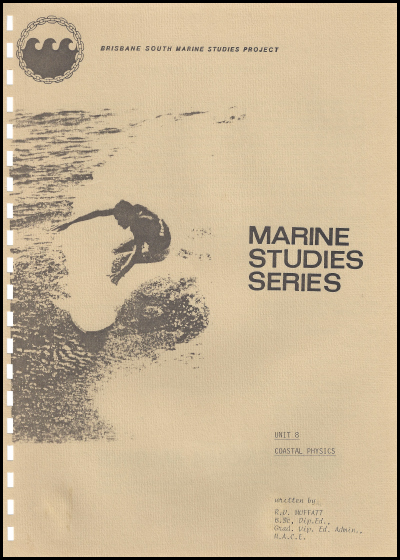1985 BSMSP Coastal Physics

ISBN : 0 959 8303 8 3
Published Date : 04 January 1985
Product Code : 1985 BSMSP
Format : pdf file for download
By Bob Moffatt
Non-commercial school licence
The publisher and author/s of this pdf file grant to the school a revocable, non-exclusive, non-transferable right and licence to use the content, exercises, lab and field work lesson notes within the school for educational purposes only.
Yearly record keeping
To ensure fair payment is made to collecting societies, educational institutions are to record the digital ISBN above.
- To do this go to the school office and ask the IT department or whoever looks after digital book licences to record the ISBN in the school digital library licence catalogue.
Copyright
Except as permitted by the Copyright Act 1968 (Cth), you may not reproduce any of the contents of this publication, without the written permission of the copyright owner.
The title to, and intellectual property rests with the publisher's author/s, illustrators, photographers and design consultants and nothing in the agreement should be construed as transferring those rights to the school.
Educational exemption
There are exemptions under the Act that allow educational and government use of text, images and music scores for educational purposes.
These exemptions are in Part VB of the Copyright Act 1968 (Cth), where you are entitled to reproduce or communicate 10% of the words or one chapter from this file for educational use within your school. If you wish to reproduce or communicate MORE than 10% contact the copyright owner.
For more information, see www.copyright.com.au and www.copyright.org.au.
Teachers Information
Rationale
Many Queenslanders live within one hours drive of the sea and many will spend their holidays at some type of coastal development. For schools that are on the coast, there is a special type of coastal environment which pervades the lifestyles of students.
It is important for students growing up in this holiday atmosphere to realise the problems associated with it. Equally important is the problem of visitors to the coastal areas adopting codes of behaviour that are different to that of their normal lifestyle.
Content
(a) General coastal features such as headlands, bays and beaches
(b) How waves are formed and affect the coast
(c) Coastal developments and engineering works (e.g. Groynes)
(d) Political implications of beach resource development
(e) Environmental implications of developing beaches, dunes or inland waterways
(f) The history of a local beach area
(g) Recreational activities that can be carried out on the coast
(h) Coastal disasters such as cyclones and floods and what to do when these occur
(i) Dangers associated with beaches and coastal bars
(j) Tides and their effects
Process
(a) Discuss different types of beach accommodation
(b) Compare different tariffs from different areas in Queensland (Lizard Island, Gold Coast)
(c) Collect information on different peoples attitudes to a local developmented.
(d) Debate the information collected rationally
(e) Understand the rules and regulations associated with Beach Homes, Units, Time Sharing etc.
(f) Understand local council building regulations regarding cyclones and floods
Skills
(a) Construct a model wave tank to illustrate principles of beech erosion
(b) Illustrate with the model the effects of groynes
(c) Use a phone book or newspaper or travel brochure to obtain tariffs for an area
(d) Plot a graph of tides over a month
(e) Go camping on the coast end as a result of this activity the
students should be able to: Demonstrate practical conservation methods Conduct a coast survey on a particular topic Catch, prepare and cook marine animals
Attitudes
(a) Become receptive to different arguments for coastal development
(b) Become aware of the fragile nature of the coast and the effects of cyclones
(c) Appreciate the need to be careful while camping
(d) Develop a respect for the surf or sea
(e) Tolerate different developers opinions and criticise only when well substantiated facts are available,
Electives
Wave models and harbour design; Coastal jobs; Foreshore Ecology
Project; Animals and Plants that inhabit the coast; Observe cyclone proofing on a construction site; study chainges that have occurred in a local area because of management.
The extent and type of resource development in any society depends on the goals and values of that society. These goals and values are not determined in isolation but are historically and culturally conditioned.
Two kinds of processes may follow from this realisation.
- Firstly, better management and planning can be called for, aimed to minimise the 'less than desirable consequences of resource development; for example, State Governments in Australia legislate to control exhaust emissions from cars to minimise the effect of these emissions on the environment.
- In addition, a re-evaluation and possibly modification of social goals may occur simultaneously. For example re-evaluation of the consequences of unrestrained personal urban mobility has lead to improved public transport systems.
Bob saw that the concepts of beach erosion caused by building too close to the coastline and the processes by which it occurred, fitted perfectly into this topic.
Contents
Waves
Wave formation
Breaking waves
Wave reflection and refraction
Beach currents
Point diffraction
Refraction
Wave set up and set down
Longshore currents
Depositional landforms from longshore currents
How Man interfere with longshore currents
Beach erosion
Classroom experiments waves, refraction, currents and groins
Tides
The importance of tides
Sun, Earth Moon systems
The Moon's orbit
Rotation fo the Moon
Gravitation and tides
Daily tides
Spring and Need tides
River tides
Investigations - Plotting the tide and Tide Models by FUSE


